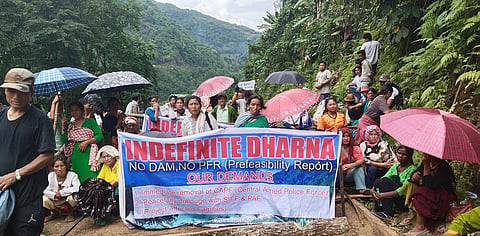

On May 23, the Arunachal Pradesh government claimed it had got a go-ahead on the contentious pre-feasibility survey for India’s largest hydroelectric dam on the Siang river from a village through a memorandum of understanding (MoU).
The development came even as the region continued to witness indefinite strikes, with activists as well as locals claiming that the MoU had only few backers in the said village.
According to a press statement issued by the Siang district administration on May 23, Arunachal Pradesh Minister for Panchayati Raj, State Transport, and Cooperation and MLA of Geku, Ojing Tasing signed the MoU with Taba Tamut and Bakin Tali, two residents of Pangkang (Kumku) village in the district who claimed to represent the community. The signing took place in presence of senior hydropower department officials, bureaucrats and political leaders.
According to the MoU, a development package of Rs 5 crore over three years will be rolled out, overseen by a newly constituted Village Development Committee (VDC) in lieu of the village’s consent to conduct the pre-feasibility survey. This Committee, composed of likely project-affected families, will spearhead village infrastructure improvements, health services, and livelihood programs. “The villagers of Pangkang (Kumku) have shown incredible foresight by backing this project. This is not only about power or water. It’s about securing our future, asserting our rights over our rivers, and honouring the spirit of cooperative development,” said Deputy Commissioner of Siang District, P N Thungon during the MoU signing ceremony.
However, Pangkang (Kumku) village residents like Tapang Jamoh told Down To Earth (DTE) that most village residents are not in favour of the dam. “We grow pineapple and paddy along the banks of the Siang. There are 85 families in this village and most of us will be impacted by the dam. The claim made by Taba Tamut and Bakin Tali that they represent the village is false. Some families may be swayed by such promises of development but ultimately, we will lose our fields and homes,” Jamoh, the gaonburha (village headman), told DTE expressing his angst. Jamoh was suspended as a gaonburha by the Siang administration last year after he openly spoke against deployment of central armed forces in the Siang valley.
Ebo Mili, an environmental lawyer and activist, considers the MoU as an attempt to bribe the locals to support the contentious dam. “Another cheap tactic used by our leaders to divide us and present a false narrative to the world. In reality, only two or three people signed the MoU. The rest are completely unaware of any such agreement. The same tactics of misinformation and a divide-and-rule policy were used with the Idu Mishmi people for the NHPC 2880MW Dibang Multipurpose Project. It is curious that the Arunachal Pradesh government announced a developmental package of Rs 5 crore for the village in exchange for the agreement signatures. Is this an open bribe with public money or was there any budget allocated to reward villages that agree to pre-feasibility report (PFR) activities?” asked Mili while speaking with DTE.
Meanwhile, with the deployment of paramilitary units in the Siang valley, protests intensified on May 23. Protestors attempted to reach Beging village in Siang district, where paramilitary personnel were deployed for a pre-feasibility survey for Siang Upper Multipurpose Project (SUMP) since May 21. They have been demanding a complete rollback of paramilitary forces and have opposed any surveys for the proposed dam with a capacity of 12.5 GW.
On May 23 morning, heeding to a peaceful protest call by SIFF (Siang Indigenous Farmers’ Forum) to oppose the paramilitary deployed, women from several villagers which may face submergence due to the proposed SUMP along with youths marched towards Beging, leaving their crop sowing activities. “There was a big posse of policemen which barricaded our peacefully protesting women and men on their way to Beging. They would not let us move beyond Geku. However, we learnt that many from neighbouring villages like Riew and Parong managed to reach the site,” said Ogak Boko, a Gaonburhi (village headwoman) from Komkar situated upstream.
According to local police from Siang district, there were attempts to set a hanging bridge on fire next to Beging village by the angry protestors. “People were stopped by the police officials armed with sophisticated weapons inside their own homesteads. We immediately persuaded them to maintain peace and called on the police officials and a local magistrate for a dialogue,” Dungge Apang, the publicity secretary for SIFF told DTE. Towards noon, executive members of SIFF and some local leaders from the Adi Students’ Union managed to reach Beging. “We have given three days’ time to the government to withdraw the central paramilitary from the entire Siang belt. We have assured them that peaceful protests will continue against any attempt to conduct PFR or deployment of central forces across the region,” Bhanu Tatak, the legal representative of SIFF told DTE.